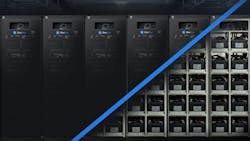Data Center Power Disruptions are Expensive — The Right Batteries Can Prevent Them
According to Uptime Institute, 80% of surveyed data center managers and operators said their organizations have experienced outages in the past three years. Power disruptions account for 43% of data center outages, with onsite system failures — specifically uninterruptible power supply (UPS) failures — being the most common cause of incident. In response to these and other sources of outages, 40% of survey respondents have increased redundancy levels in their data centers in the past three to five years. The batteries that are at the core of these backup power systems play a vital role in supporting data center uptime, meaning the right choice in chemistry type is crucial to ensuring the effectiveness of these redundancy investments. The right battery can be the reason expensive disruptions and repairs are avoided.
How the right UPS batteries can prevent power failures
Most UPS systems contain backup batteries that are expected to perform reliably under any circumstances. UPS batteries are typically arranged in paralleled strings to provide adequate power and run time to the UPS in the event of an outage. If any single cell in one of these batteries fails, the battery string may not operate, putting it at risk of being unable to supply enough power and/or run time when an outage occurs.
This kind of internal failure produces an open circuit in lead-acid and lithium-ion batteries, which can halt string operation. The resulting emergency situation requires an immediate service visit to replace the faulty battery components and can be exceptionally costly. The worst-case scenario is if the battery string fails while discharging during a critical outage event.
Luckily for data centers, more resilient battery options — particularly nickel-zinc (NiZn) chemistries — are now broadly available. Contrary to incumbent UPS battery types, when a NiZn cell becomes weak or depleted, it remains conductive, allowing the rest of the battery string to continue operating. This drastically reduces the risk of battery downtime, protecting data centers from costly outages and emergency equipment replacements.
NiZn batteries also tolerate string failure to a much greater degree, meaning that if one battery cabinet in a system goes offline — for whatever reason — the remaining strings can continue to operate at elevated currents. Lithium-ion batteries, in contrast, have hard current limits that would prevent this flexibility in a typical installation.
Other Reliability Benefits of Nickel-Zinc Battery Technology
NiZn and lithium-ion batteries boast impressive 10-15 year lifespans, well above (2-3x) that of lead-acid technology. Additionally, unlike lead acid, NiZn has an inherently low internal resistance and very low impedance rise over time. Because of these valuable attributes, NiZn batteries can sustain higher current discharges and support these higher currents for the entirety of their operational lives.
For more prolonged power outages — from hours to days or even weeks — diesel generators remain the go-to solution for temporary power production. These generators, however, require batteries to crank and start. For this purpose, starter batteries with high current discharge capability like NiZn allows for better generator reliability. The battery voltage drop stays constant despite the state of health, ensuring constant delivery of powerful starting performance.
NiZn batteries are stable, safe, and feature long lifespans with little-to-no maintenance necessary. By supporting the backup generators that are required beyond the UPS system, NiZn technology for generator starting offers another level of data center operational resiliency.
NiZn Batteries Keep Data Centers Up and Running
The unique properties of NiZn technology prevent string and generator starter battery failures, helping data centers avoid costly outages while maintaining service reliability. In addition to its reliability, nickel-zinc batteries boast a smaller footprint, improved sustainability, and increased safety, making them the ideal choice for data center operators that want to put an end to expensive, disruptive outages.
Steve Jennings is a Sr. Vice President of Sales and Marketing at ZincFive, a world leader in innovation and delivery of nickel-zinc batteries and power solutions. Contact ZincFive to learn how their technology leverages the safety and sustainability of nickel-zinc chemistry to provide high power density and performance for mission critical applications.



